Rod Vanda (Vanda, this. Orchidaceae) includes over 40 species. The color palette is multifaceted, most often blue, purple or pink. Coloring can be variegated - in the form of a scattering of small veins, or monophonic. The smell is fragrant, but not everyone has it. The flowers are large and saturated bright, it is noticeable at the stage of a full flowering period. There are no periods of growth and dormancy; the abundance of flowering depends on the conditions of detention. The duration of flowering is about three months. It has another leaf arrangement of a juicy green hue and a long peduncle; it can have up to 15 buds.
Content
Description and grades
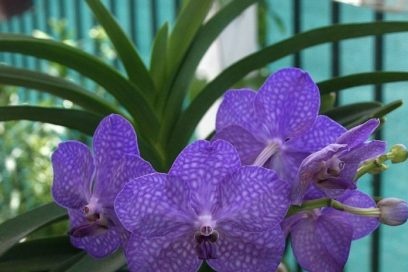 Orchid Wanda - epiphyte, has a unique powerful root system, protected by a keratinized layer of cells, to protect the plant from drying out and the harmful effects of the sun. This structure allows you to get moisture also from the atmosphere.
Orchid Wanda - epiphyte, has a unique powerful root system, protected by a keratinized layer of cells, to protect the plant from drying out and the harmful effects of the sun. This structure allows you to get moisture also from the atmosphere.
Popular varieties of experienced gardeners:
- Vanda blue (V. coerulea) - the color of the flowers is bluish-blue, covered with a mosaic of veins of a saturated dark shade.
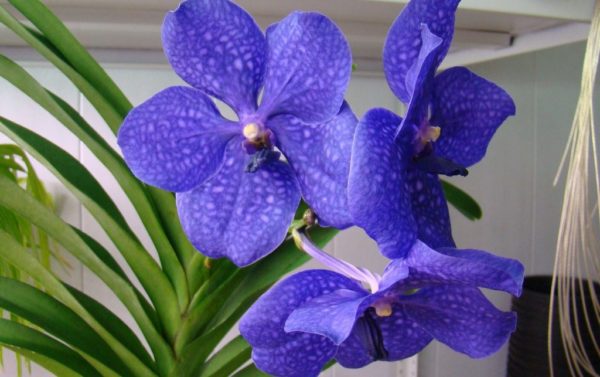
Wanda Blue The flowers are large, smell pleasantly, are located on one peduncle about 10-12 flowers. The lip is poorly developed, smaller in diameter and has a darker color.
- Vanda tricolor (V. tricolor) - larger leaves, leathery, stalk high, up to 1.5m in length.
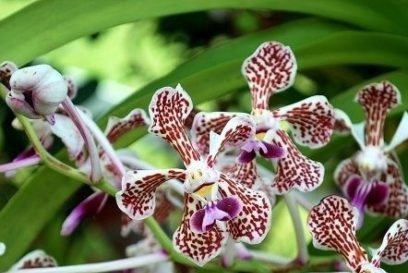
Wanda tricolor The flowers are small in size, on a peduncle no more than ten, in shape resemble a star. Petals are white and cream-colored, covered with burgundy spots, wavy along the edge. The lip is divided into three parts, corresponds in diameter to the petal, resembles a guitar in shape, the color is deep raspberry. It is easy to make a plant bloom, it is enough to reduce watering for a while.
- Wanda Sandera - large leaves and flowers.
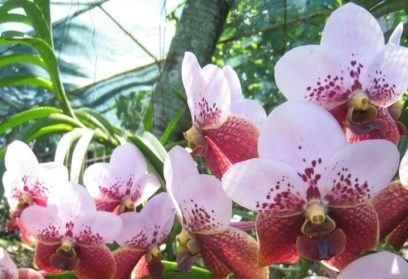
Wanda Sander The color of the petals, pale pink decorated with a white rim. The lip in size, like a blue Wanda, is a yellow-pink hue.
- Wanda Rothschild is a hybrid of Wanda's blue orchid and Sander.
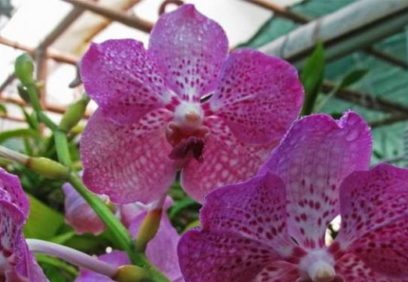
Wanda Rothschild During flowering, the buds are small, but numerous, up to 20 in the brush, blue.
- Wanda is grossed - has a long climbing stalk. The size of the flowers is average, up to 10cm, have a slightly wavy edge.
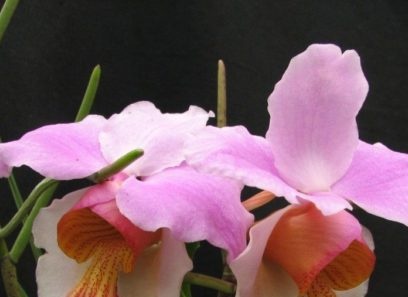
Wanda Gummy The shape is oval or rhomboid. Petals yellow with burgundy dots on the surface. The lip is divided in half, a bright lilac hue, elongated in the form of a wedge. There are many roots, they are in a hanging position.
Wanda Orchid Care at Home
The flower of Wanda is a liana in its own element, it encircles the crowns of trees and does not need soil. Therefore, it is recommended to grow it in limbo in a basket or pots. Another more modern option is the Wanda orchid in a vase. It should be narrowed at the top, but wide at the bottom. Narrow and tall will not fit. Be sure to put hydrogel balls or expanded clay on the bottom for adequate root nutrition. In this form, Wanda should not be entirely, it is desirable to plant it in such a way that the peduncle goes beyond the upper level of the vase. Orchid cultivation in a glass flask will give an elegant look.
You can also use the Vanda orchid variant in a small-diameter pot, plastic with side holes, in which you need to carefully straighten the roots and fix them with a thin wooden rod or sliver.Fill the cavity between the roots with a substrate: large pieces of pine bark and moss in a ratio of 2: 1, plus a little charcoal (you can buy ready-made ones at the pet store). Serves for about six months, then need to be replaced.
The plant has Far Eastern roots and is accustomed to the tropics, therefore it is very demanding and will not tolerate “through the sleeves” relationship. Therefore, if you are a beginner, be sure to read our instructions on the rules for the care and maintenance of the capricious sissy Wanda at home.
Temperature and humidity
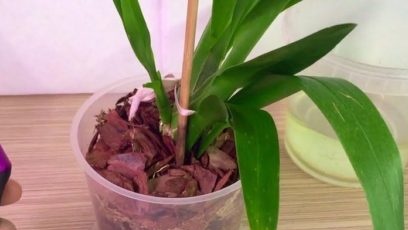 You need to look after the Wanda orchid from the first day. Before you buy a seedling, you need to take care of under what conditions it will grow. The temperature in the room should correspond to the hot climate, optimally adhere to from 20 to 30ºС, in the daytime to 25º, in the evening from 14-17º, depending on the season. A slight daily temperature difference of 8-10º is allowed to stimulate flowering.
You need to look after the Wanda orchid from the first day. Before you buy a seedling, you need to take care of under what conditions it will grow. The temperature in the room should correspond to the hot climate, optimally adhere to from 20 to 30ºС, in the daytime to 25º, in the evening from 14-17º, depending on the season. A slight daily temperature difference of 8-10º is allowed to stimulate flowering.
An ideal place would be a window on the south side, with constant access to sunlight for more than 12 hours a day (it needs to be darkened at noon) and well-ventilated. In winter and in rain it requires additional lighting due to fluorescent lamps.
It is necessary to strictly observe the parameter of air humidity in the room, the interval is from 70-80%, excessive dryness or moisture is destructive. To maintain this parameter, spray the root system of the Wanda orchid with warm, pre-infused water. Do this in the morning, do not leave excess drops of water on the roots. In winter, you can put nearby fountains with water or other devices for automatic humidity control.
Watering and replanting
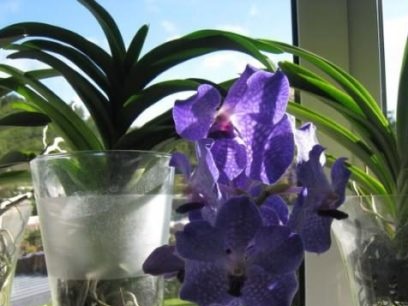 Watering in spring and summer is also carried out in the morning, daily, in winter every 2-3 days. The method depends on the method of cultivation. The substrate must be soaked in warm water for about 20 minutes, between waterings, it must have time to dry. If the container is a glass vase, then use the filling method - warm water fills the roots (not carefully touching the axils of the leaves) and in this form costs 15-20 minutes. If the color of the roots turns green, drain the water. Wipe the plaque on the walls with a damp cloth or water under the tap, then wipe the main thing dry. Once every three months, watering with the filling method is done with the addition of lemon juice.
Watering in spring and summer is also carried out in the morning, daily, in winter every 2-3 days. The method depends on the method of cultivation. The substrate must be soaked in warm water for about 20 minutes, between waterings, it must have time to dry. If the container is a glass vase, then use the filling method - warm water fills the roots (not carefully touching the axils of the leaves) and in this form costs 15-20 minutes. If the color of the roots turns green, drain the water. Wipe the plaque on the walls with a damp cloth or water under the tap, then wipe the main thing dry. Once every three months, watering with the filling method is done with the addition of lemon juice.
A transplant is not necessary if there are no such criteria:
- the roots have little space, no growth rate is observed;
- poorly selected substrate, constant humidity;
- signs of rot.
If Vanda's orchid was bought at a store and you need to change the capacity, then you should wait a bit. The best time for planting and care is the beginning of spring. Before transplanting, slightly moisten the roots, this makes the substrate easier to leave, and the roots will be softer.
Fertilizer and reproduction
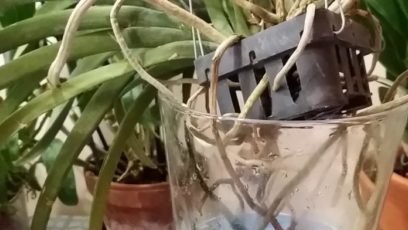 Care and growing at home involves many nuances. During the period of vegetative growth, after the end of flowering, you can carry out the feeding process. Once a month. For this, special fertilizers with the addition of potassium monophosphate are suitable. Dilute with water in a larger dilution than indicated on the packaging and add when spraying or watering. But don't overdo it
Care and growing at home involves many nuances. During the period of vegetative growth, after the end of flowering, you can carry out the feeding process. Once a month. For this, special fertilizers with the addition of potassium monophosphate are suitable. Dilute with water in a larger dilution than indicated on the packaging and add when spraying or watering. But don't overdo it
When the petals begin to dry, the peduncle needs to be cut. Moisturize to reduce and take the plant out into the open air, so it will quickly restore strength. And you can again observe the best flowering period of Wanda in all its glory.
Very rarely, the occurrence of the lateral process (children) occurs, then your copy can be propagated. It can be separated when it grows more than five centimeters, a slice is processed. Such a mini-copy must be placed in greenhouse conditions, after it takes root and grows, gradually accustom to room conditions. Transplant carry out just like an adult plant.
A more frequent way is to cut off the top of the stem with aerial roots, and process the place of cutting of the bottom. At the top, remove the lower leaves and leave to dry, the next day put it in a substrate and the cortex and sphagnum, wrap it with a film - to create a greenhouse effect.
Root growth and disease control
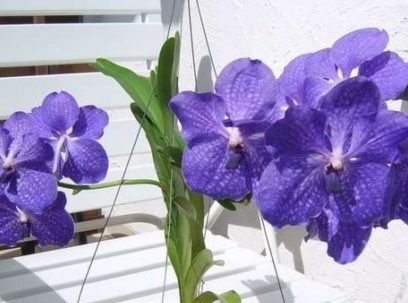 If plant care is compromised, Wanda orchids may lose some of their roots. You can grow new ones, for this, get an orchid and lower it into a solution with a growth enhancer, after separating the damaged roots. Then move it into a pre-prepared transparent pot with expanded clay, cover with moss on top. Clean in a warm, well-ventilated place. Spray along the edges, no need to water. The result will be visible after about a month.
If plant care is compromised, Wanda orchids may lose some of their roots. You can grow new ones, for this, get an orchid and lower it into a solution with a growth enhancer, after separating the damaged roots. Then move it into a pre-prepared transparent pot with expanded clay, cover with moss on top. Clean in a warm, well-ventilated place. Spray along the edges, no need to water. The result will be visible after about a month.
To protect the plant from the disease, examine it several times a day for pests and diseases.
The appearance of brown spots at the base of the leaf indicates the presence of fungal infection (fusarium), treatment should be carried out with a solution of fundazole separately from neighboring plants. The reason is excessive moisture and heat, as well as untimely removal of dead roots and leaves. It can be transmitted through water or by airborne droplets.
Excess moisture also provokes plant rot, the leaves are sluggish and wrinkled, spots can appear on them. Salvation is an emergency transplant:
- it is necessary to remove all affected areas;
- treat the whole plant with a fungicide.
Rinse and disinfect the container, clean in a dark place until there are signs of growth. Change substrate if used.
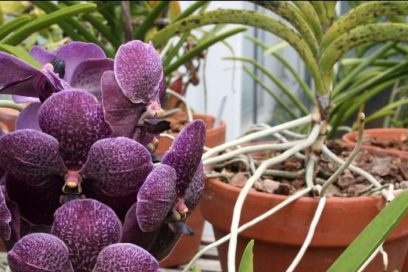 And with a lack of water, heat or direct sunlight yellowing of leaves, and the flowers fall. The appearance of cracks on the sheet plates indicates excessive fertilizer, the prevalence of nitrogen in the soil, mechanical damage or cooling immediately after irrigation. Ring spots imply a viral infection, in which case the plant must be isolated from others and treated with a fungicide. A long absence of flowering is not a sign of disease, in order to stimulate the orchid to bloom, try to correct the temperature and add more light.
And with a lack of water, heat or direct sunlight yellowing of leaves, and the flowers fall. The appearance of cracks on the sheet plates indicates excessive fertilizer, the prevalence of nitrogen in the soil, mechanical damage or cooling immediately after irrigation. Ring spots imply a viral infection, in which case the plant must be isolated from others and treated with a fungicide. A long absence of flowering is not a sign of disease, in order to stimulate the orchid to bloom, try to correct the temperature and add more light.
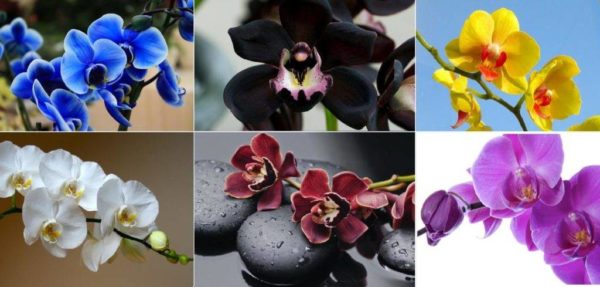 You may be interested in:
You may be interested in:“We are responsible for those who have tamed”, quoting a well-known expression, we want to conclude that all plants need careful care and care. And Wanda is no exception, so that she will please you with her divine appearance for a long time, show a bit of patience and your hard work will not be wasted. Orchid Wanda in the glass looks amazingly beautiful.

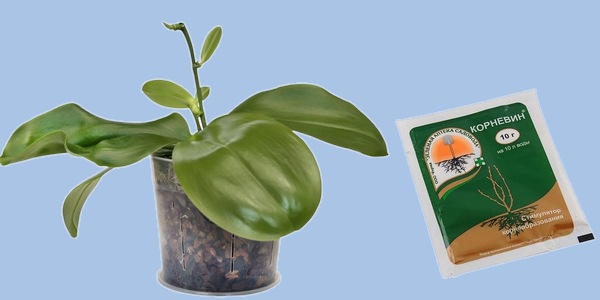
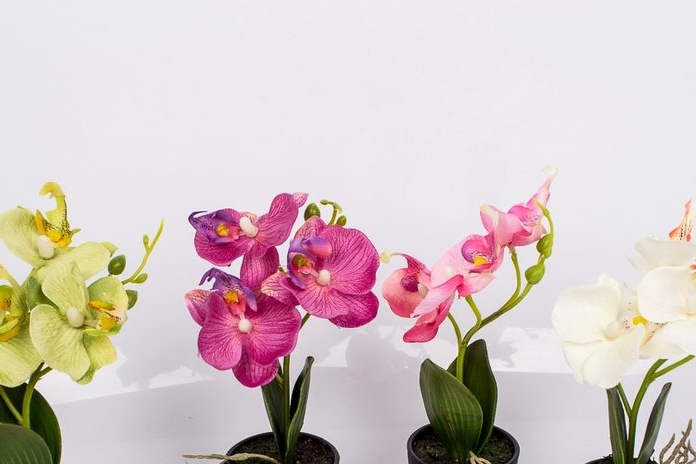
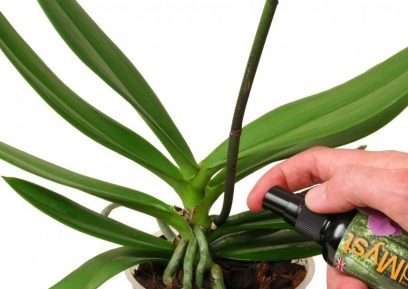
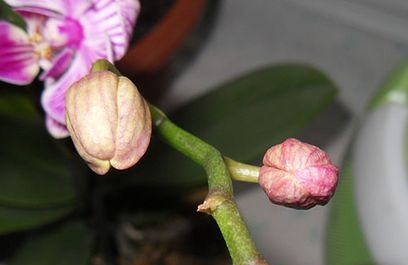 Reasons why orchids fall flowers and what to do
Reasons why orchids fall flowers and what to do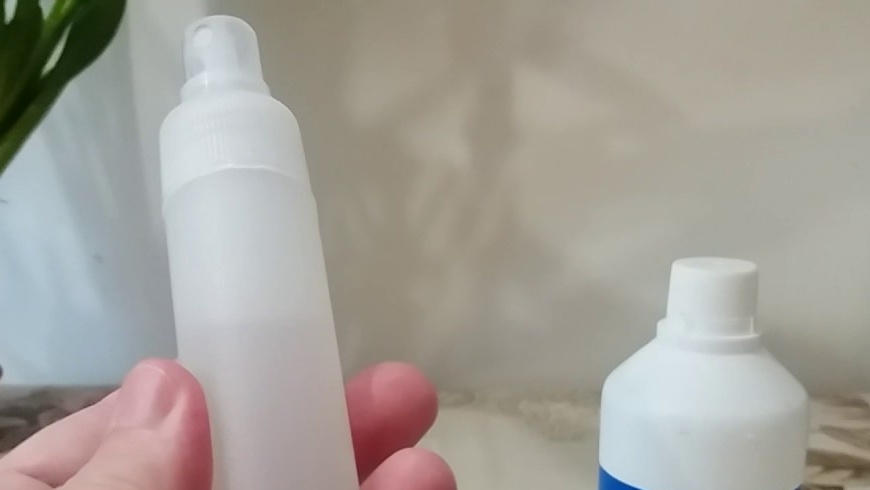 How to use hydrogen peroxide for orchids and why
How to use hydrogen peroxide for orchids and why Midges are wound up in the orchid: effective ways to get rid
Midges are wound up in the orchid: effective ways to get rid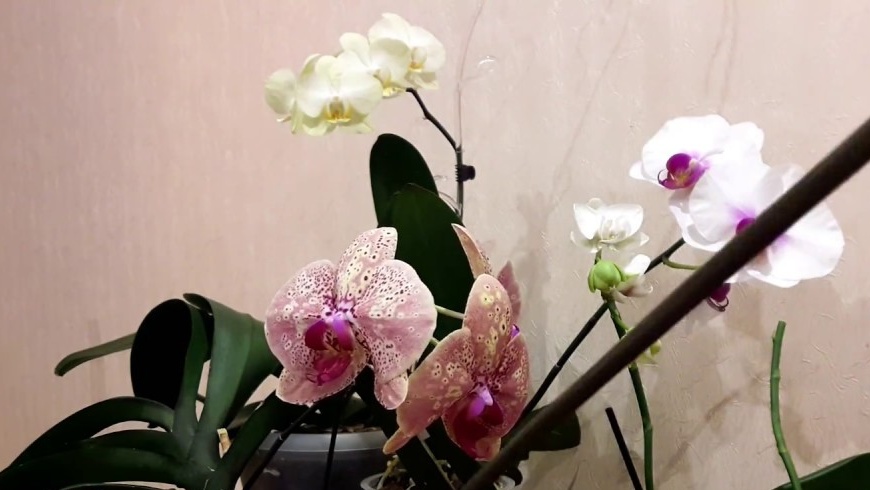 Is it possible to transplant an orchid during flowering
Is it possible to transplant an orchid during flowering